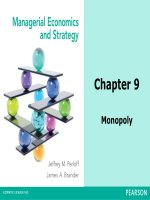Managerial economics strategy by m perloff and brander chapter 16 government and business
Bạn đang xem bản rút gọn của tài liệu. Xem và tải ngay bản đầy đủ của tài liệu tại đây (341.13 KB, 32 trang )
Chapter 16
Government and
Business
Table of Contents
•
16.1 Market Failure & Government Policy
•
16.2 Regulation of Imperfectly Competitive Markets
•
16.3 Antitrust Law & Competition Policy
•
16.4 Externalities
•
16.5 Open-Access, Club, & Public Goods
•
16.6 Intellectual Property
16-2
© 2014 Pearson Education, Inc. All rights reserved.
Introduction
• Managerial Problem
–
–
Consider a competitive market in which all firms use the same technology, but one
firm invents a new, lower-cost process.
Should that firm patent its invention or keep it a trade secret? If the innovating firm
manufactures the good itself, under what conditions can it charge the monopoly
price? If the innovating firm obtains a patent, will the firm earn more if it produces
itself or if it licenses its new process to other firms?
• Solution Approach
–
We need to examine market failures that arise due to incomplete property rights and
government policies that directly regulate, assign, and enforce property rights.
• Empirical Methods
–
–
16-3
Governments respond to market failures that arise from non-competitive market
structures in a preventive or remedial approach with regulation, antitrust, and
competition policy.
Governments also respond to externalities, a market failure due to incomplete
property rights (open-access, club, public goods, patents, and copyrights).
© 2014 Pearson Education, Inc. All rights reserved.
16.1 Market Failure &
Government Policy
• Economic Efficiency and Government Policy
– Perfectly competitive markets achieve economic efficiency: total surplus is
maximized. However, most markets exhibit a significant market failure,
which substantially reduce economic efficiency and result in deadweight
losses.
– One important rationale for government policy is to reduce or eliminate
market failure (deadweight loss), but some may win and others lose.
– Economists evaluate the desirability of government policy with two lenses:
the Pareto Principle and Cost-Benefit Analysis.
• The Pareto Principle
– Pareto Principle: change that benefits some people without harming
anyone else
– A government policy that eliminates a market failure is a Pareto
improvement if the reallocation of goods or productive inputs helps at
least one person without harming anyone else.
– The outcome is Pareto efficient once all possible Pareto improvements
have occurred. So, any additional change would harm at least one person.
16-4
© 2014 Pearson Education, Inc. All rights reserved.
16.1 Market Failure &
Government Policy
• Cost-Benefit Principle
– The cost-benefit principle: a change is desirable if its benefits exceed the
costs.
– The cost-benefit principle supports policies that increase total surplus,
even if some will be harmed.
• Pareto and Cost-Benefit Compared
– Any policy that generates a Pareto improvement satisfies the cost-benefit
principle. If some people gain from a policy and no one suffers a loss, then
the aggregate benefit is positive. However, the converse is not true.
– In practice, policies that have large net benefits and small distributional
effects tend to generate broad support. But, policies with small net
benefits and large distributional effects are likely to be more contentious,
especially if the distributional effect is regressive (worse income
distribution).
16-5
© 2014 Pearson Education, Inc. All rights reserved.
16.2 Regulation of Imperfectly
Competitive Markets
• First Approach to Eliminate Market Failure
– A government can eliminate imperfectly competitive pricing by a
monopolist with a direct approach: own the monopoly and set relatively
low prices.
– Example: many governments own and operate electric power and water
utilities.
• Second Approach to Eliminate Market Failure
– A government can change the market structure using antitrust or
competition laws.
– Example: the U.S. government increased the number of aluminum
manufacturers during World War II, ending Alcoa’s monopoly.
• Third Approach to Eliminate Market Failure
– A government can regulate the industry to prevent firms from setting
excessively high prices.
– We will focus on this third approach next.
16-6
© 2014 Pearson Education, Inc. All rights reserved.
16.2 Regulation of Imperfectly
Competitive Markets
• Optimal Price Regulation: Cap Price
– A government can eliminate the deadweight loss of monopoly by imposing
a price cap equal to the price that would prevail in a competitive market.
– Example: Price cap regulation is used for telecommunications monopolies
in 33 U.S. states, and many countries including Australia, Canada,
Denmark, France, Germany, Mexico, Sweden, and the U.K.
• Efficient Cap Price Regulation: Graph Analysis
– In Figure 16.1, an unregulated monopoly maximizes its profit at em, where
MR = MC. The monopoly sells 6 units at a price of $18 per unit, and
society suffers a deadweight loss, –C – E.
– The government sets a price cap at $16 (horizontal demand for the
monopolist) and the regulated monopolist maximizes profit at eo, where
MRr = MC. The monopolist sells 8 units at the maximum price allowed of
$16.
– This is an optimal price cap because it gives a competitive price and the
deadweight loss is eliminated.
16-7
© 2014 Pearson Education, Inc. All rights reserved.
16.2 Regulation of Imperfectly
Competitive Markets
Figure 16.1
Optimal Price
Regulation
16-8
© 2014 Pearson Education, Inc. All rights reserved.
16.2 Regulation of Imperfectly
Competitive Markets
• Non Optimal Price Regulation Due to Poor Information
– Well-intentioned government regulators often fail to regulate monopolies
optimally because of limited information about the monopoly’s demand
and cost curves.
– If regulators rely on the monopoly or on industry experts for information,
they may be misled, and the price cap may be above or below the efficient
level resulting in a deadweight loss.
• Non Optimal Price Regulation Due to Inability to Subsidize
– If a monopolist exhibits economies of scale, a price cap regulation based
on MC may force the monopolist to shutdown because MC < AC, unless it
gets a subsidy.
– Given that subsidizing a monopolist may not be politically viable, a better
regulation is to set the price cap equal to the average cost so that firm
continues to operate (Pareto improvement over marginal cost pricing).
16-9
© 2014 Pearson Education, Inc. All rights reserved.
16.2 Regulation of Imperfectly
Competitive Markets
• Regulatory Capture
– Some regulators may be captured so that they regulate in the manner that
the industry wants (the interests of the industry ahead of the public
interest).
– Firms engage in rent seeking practices (devote effort and expenditures to
gain a rent of profit from government actions) to capture some regulators.
– A captured regulator’s objective might be to keep prices high rather than
low, so they may impose entry restrictions to keep potential competitors
out.
• Applying the Cost-Benefit Principle to Regulation
– Regulating all markets where P > MC (market failure) will not increase
total surplus because many regulations would not pass a cost-benefit test.
– Regulation has its own costs: costs of gathering information, costs of
honest mistakes, costs of captured regulators, costs of rent seeking.
– Price regulation passes a cost-benefit test only when the market failure is
large enough that the benefits from significantly reducing it exceed the
cost associated with regulation.
16-10
© 2014 Pearson Education, Inc. All rights reserved.
16.3 Antitrust Law &
Competition Policy
• Antitrust Laws in the U.S.
– In the late nineteenth century, cartels or trusts, were legal and were common
in the United States. Oil, railroad, sugar, and tobacco trusts raised prices
substantially above competitive levels.
– The U.S. Congress passed the Sherman Antitrust Act in 1890 and the Federal
Trade Commission Act of 1914, which prohibited firms from explicitly agreeing
to take actions that reduce competition. So, price fixing is a per se violation: It
is strictly against the law and firms have no possible mitigating justifications.
– The two governmental agencies responsible for U.S. antitrust policy are the
Antitrust Division of the Department of Justice (DOJ) and the Federal Trade
Commission (FTC).
• Why do Cartels Persist Despite Antitrust Laws?
– First, international cartels and cartels within certain countries operate legally.
– Second, some illegal cartels operate believing that they can avoid detection
or that the punishment will be insignificant.
– Third, some firms are able to coordinate their activities without explicitly
colluding and thereby running afoul of competition laws.
16-11
© 2014 Pearson Education, Inc. All rights reserved.
16.3 Antitrust Law &
Competition Policy
• Mergers
– To prevent firms from forming a monopoly, most antitrust and competition
laws restrict the ability of firms to merge if the net effect is to harm
society.
– Whether a merger helps or harms society depends on which of its two
offsetting effects—reducing competition and increasing efficiency—is
larger.
– Proposed U.S. mergers beyond a certain size must be reported and
evaluated by either the DOJ or the FTC. These agencies block mergers that
they believe harm society. But, firms can appeal this decision to the
federal courts.
• Predatory Actions
– Antitrust policy also prevents predatory pricing: a firm charges a price
below MC or AC to drive its rivals out of business and then raise its price.
– It is difficult for the DOJ to demonstrate predatory pricing because the firm
does not benefit from predating if its rivals or other firms reenter the
market as soon as it raises its price.
16-12
© 2014 Pearson Education, Inc. All rights reserved.
16.3 Antitrust Law &
Competition Policy
• Regulation of Vertical Relationships
– Antitrust policy also addresses vertical interactions between a firm and its
customers or suppliers.
– Vertical actions that competition authorities investigate include resale
price maintenance, refusal to deal, exclusive dealing, and price
discrimination.
• Resale Price Maintenance
– A manufacturer engages in resale price maintenance (RPM) if it requires
the retailers that sell its product to charge a price no lower than a price it
specifies.
– In the U.S., RPM was per se illegal. However, since 2007, it is a rule of
reason or cost-benefit: RPM is illegal only if it has a net negative effect on
competition.
– Today, restrictions on dealers’ prices or other activities are usually legal if
the manufacturer acts unilaterally.
16-13
© 2014 Pearson Education, Inc. All rights reserved.
16.3 Antitrust Law &
Competition Policy
• Refusal to Deal
–
–
–
Integrated firms operate in downstream and upstream markets (aluminum & bauxite
markets).
If the integrated firm dominates both markets, and refuses to sell the input to other
downstream rivals, it may be charged with a refusal to deal.
In general, a firm has no obligation to sell to another firm. However, if a dominant
firm refuses to sell to one firm, it needs to provide a business reason other than
destroying competition.
• Exclusive Dealing
–
–
Exclusive dealing arises when a firm sells its product only to customers who agree to
buy from that firm and not from its rivals, or when a firm is forced to sell to only one
buyer and not to the buyer’s rivals.
Exclusive contracts are legal if it promotes efficiency and competition in the market
by guaranteeing a source of supply, lowering transaction costs, or creating dealer
loyalty. However, they are illegal if new firms cannot enter the market.
• Price Discrimination
–
16-14
Price discrimination is legal unless it harms competition (Robinson-Patman Act of
1936).
© 2014 Pearson Education, Inc. All rights reserved.
16.4 Externalities
• Effects of Actions that Occur Outside Markets
– When a person’s well-being or a firm’s production capability is directly
affected by the actions of other consumers or firms rather than indirectly
through changes in prices, it is called externality (the effect occurs outside
market transactions).
• Negative and Positive Externalities
– Negative Externality: A chemical plant that dumps its waste into a lake,
reducing the profits of a firm that rents boats and the utility of visitors to
the lake. Because the chemical plant does not pay for the harm caused to
the other firm and visitors, it dumps too much.
– Positive Externality: A homeowner that plants nice trees in his property
increases the value of the neighbor’s homes too. Because this homeowner
is not compensated for the benefits she gives to the community, too little
of such externality is produced.
16-15
© 2014 Pearson Education, Inc. All rights reserved.
16.4 Externalities
• Negative Externality: Paper Industry and Air and Water Pollution
– We examine a competitive market in which firms produce paper and emit
by-products of the production process—such as air and water pollution—that
harm people who live near paper mills.
– Paper firms do not pay for the harm from the pollution they cause. Each
firm’s private cost includes its direct costs (labor, energy, and wood pulp),
but not the indirect costs of the harm from the externality. The true social
cost for society includes private costs and indirect costs.
• Market Graphical Analysis
– In Figure 16.2, the competitive equilibrium, ec, is determined by the
intersection of the demand curve and the private marginal cost curve, MCp.
Too much paper is produced (Qc = 105 tons) and sold at low prices (pc =
$240 per ton) because the firm ignores the cost of pollution. E represents
the deadweight loss.
– The social optimum, es, is at the intersection of the demand curve and the
social marginal cost curve, MCs = MCp + MCx, where MCx is the marginal cost
of the pollution. There is no deadweight, Qs = 84 and ps = $282 per ton.
16-16
© 2014 Pearson Education, Inc. All rights reserved.
16.4 Externalities
Figure 16.2
Welfare
Effects of
Pollution in a
Competitive
Market
16-17
© 2014 Pearson Education, Inc. All rights reserved.
16.4 Externalities
• Regulation to Reduce Externalities
– If a government has sufficient knowledge about pollution damage, the
demand curve, costs, and the production technology, it can force a
competitive market to produce the social optimum.
– The government can control pollution directly or indirectly. It can control
pollution directly by setting emissions standards or taxing pollution with
emission fees or effluent charges. It can do it indirectly by limiting outputs
or inputs.
– Direct pollution regulation encourages firms to adopt efficient new
technologies.
• Another Approach to Reduce Externalities: Property Rights
– Government agencies or courts could clearly assign property rights giving
one party the right to pollute or the other party the right to be free from
pollution.
– If clear property rights can be established, pollution can be priced and the
externality problem can be reduced or eliminated.
16-18
© 2014 Pearson Education, Inc. All rights reserved.
16.4 Externalities
• Emissions Standards
– In Figure 16.2, the government can maximize total surplus by enacting an
emission standard that prohibits paper mills to produce more than 84 units
of paper per day (pollution is directly related to paper output).
– Limitations: the government may not have full information to set the
correct emission standard, or may have limited monitoring and enforcing
resources.
• Emission Fees
– In the paper mill case, if the government knows the marginal cost of the
emissions, MCx, it can set the output tax, t(Q), which varies with output, Q,
equal to this marginal cost curve: t(Q) = MCx.
– Usually, the government sets a specific tax rather than a tax that varies
with the amount of pollution.
16-19
© 2014 Pearson Education, Inc. All rights reserved.
16.4 Externalities
• Property Rights and the Coase Theorem
– Coase Theorem (Coase, 1960): a polluter and its victim can achieve the
optimal levels of pollution if property rights are clearly defined and they
can bargain effectively.
– The Coase Theorem demonstrates that unclear property rights is the root
of the externality problem. However, it may not be practical for most
cases.
• Secret Garden Tea House & Fixit Car-body Shop Case
– Fixit causes noise pollution, which hurts business at the Secret Garden.
– As Table 16.1 shows, if Fixit works on more cars per hour, its profit
increases, but the resulting extra noise reduces the tea house’s profit. The
last column shows the total profit of the two firms. Having the auto body
shop work on one car at a time maximizes their joint profit. Anything else
is inefficient.
16-20
© 2014 Pearson Education, Inc. All rights reserved.
16.4 Externalities
Table 16.1 Daily Profits Vary with Production and
Noise
16-21
© 2014 Pearson Education, Inc. All rights reserved.
16.4 Externalities
• Unclear Property Rights for Fixit and Secret Garden
– Initially, because property rights are not clearly defined, Fixit won’t
negotiate with the Secret Garden. After all, why would Fixit reduce its
output and the associated noise, if the Secret Garden has no legal right to
be free of noise?
– So, Fixit works on two cars per hour and maximizes its profit at 400 (Table
16.1). The excessive noise drives the Secret Garden out of business; joint
profit is 400.
• Defining Clear Property Rights for Fixit & Secret Garden
– Suppose the Secret Garden gets the right to silence. If it forces Fixit to
shut down, the Secret Garden makes 400 and their joint profit is 400.
However, if Fixit works on one car, its gain is 300, while the Secret Garden
loses only 200.
– The firms should be able to reach an agreement where Fixit pays the tea
house between 200 and 300 for the right to work on one car. Under such
an agreement, their joint profit is maximized at 500.
– If Fixit gets the right to noise, a similar beneficial outcome is produced.
16-22
© 2014 Pearson Education, Inc. All rights reserved.
16.4 Externalities
• Three Lessons from the Coase Theorem
– If property rights are not clear, one firm pollutes excessively and joint
profit is not maximized.
– Assigning property rights maximizes joint profit, regardless of who gets
the rights.
– Who gets the property rights affects the distribution of the joint profit.
• Coase Theorem Limitations: Transaction & Information Costs
– If transaction costs are so high that it doesn’t pay for the two sides to
meet, bargaining is not possible.
– If either party lacks information about the costs or benefits of reducing
pollution, bargaining is not possible either.
– For these reasons, the Coase Theorem is not viable in many pollution
cases.
16-23
© 2014 Pearson Education, Inc. All rights reserved.
16.5 Open-Access, Club, & Public
Goods
• Rivalry and Exclusion Properties
– Rivalry: If Jane eats an orange, that orange is gone so no one else can
consume it.
– Exclusion: If Jane owns an orange, she can prevent others from consuming
it.
– No-rivalry and no-exclusion: if Jane breaths clean air, others can still
‘consume’ clean air and she cannot prevent others from breathing.
– Oranges have rivalry and exclusion properties, while clean air has norivalry and no-exclusion properties.
• Goods and Rivalry and Exclusion Properties
–
–
–
–
16-24
Private Goods have rivalry and exclusion properties
Open-Access Common Property have rivalry and no-exclusion properties
Club Goods have no-rivalry and exclusion properties
Public Goods have no-rivalry and no-exclusion properties
© 2014 Pearson Education, Inc. All rights reserved.
16.5 Open-Access, Club, & Public
Goods
• Open-Access Common Property
– Open Access Fishery: Anyone can fish in an open-access fishery so it is
nonexclusive, but a fish is rival.
– Problem: Each fisher wants to catch a given fish before others so as to
gain the property right to that fish, even if that means catching fish while
they are still young and small. The lack of clearly defined property rights
leads to overfishing.
– Externality: The social cost of catching a fish is the private cost plus the
externality cost from reduced current and future populations of fish. Thus,
the market failure arising from open-access common property is a
negative externality.
– Other examples: Oil and natural gas reserves, public freeways.
• Solutions to Common Property
– Government regulation that restricts access to the commons (first-come,
first-served basis; entrance fee or tax)
– Assigning Clear Property Rights converts open-access common property
into private property and removes the incentive to overuse it.
16-25
© 2014 Pearson Education, Inc. All rights reserved.









